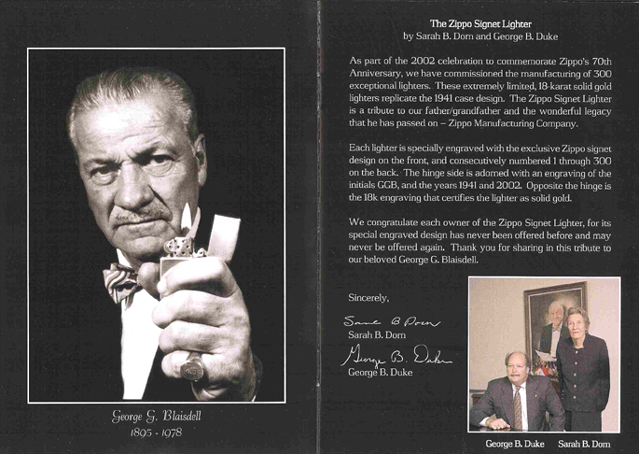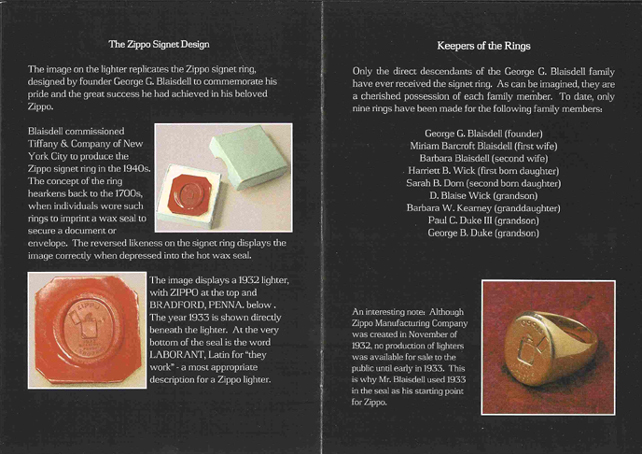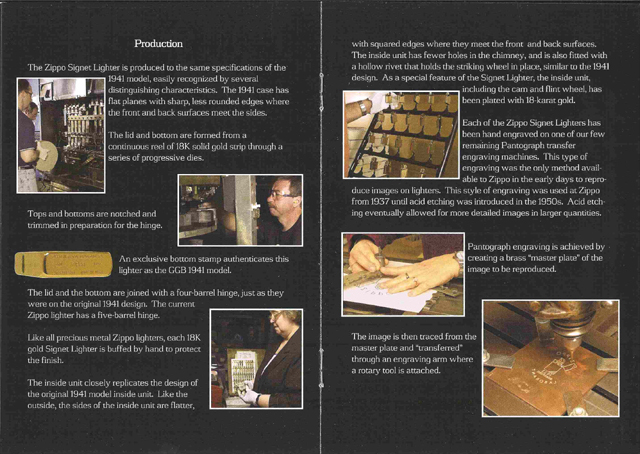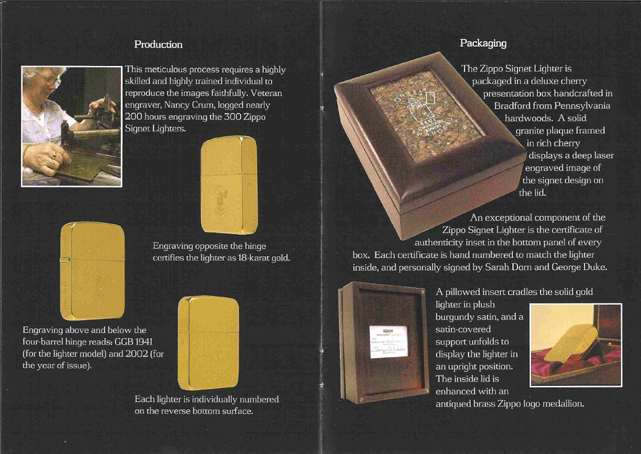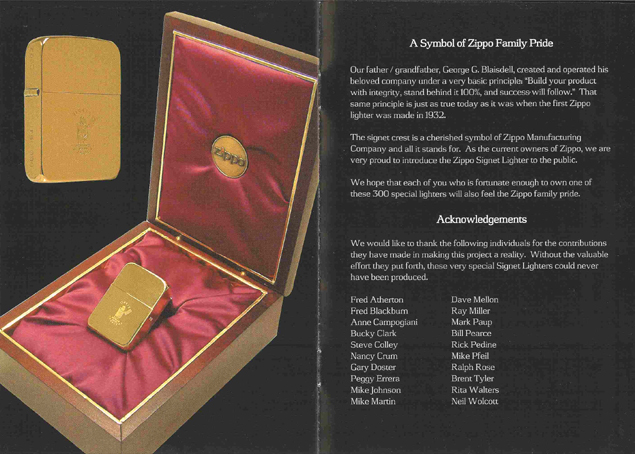| George
Grant Blaisdell was born on June 5, 1895, in Bradford,
Pennsylvania. He was the son of Philo and Sara Blaisdell. He lived
on the corner of what is now Congress Street and Blaisdell Avenue
in Bradford. Blaisdell attended school until he walked out in the
fifth grade. He hated school and told his family he was not going
back. His father sent him to a military academy, but after two
years he was suddenly dismissed. No one knows for sure why he was
dismissed, but his hatred of formal schooling may be a good
explanation. After returning home, he was put to work in the
family business, Blaisdell Machinery Company. This is where
Blaisdell learned the skills that would eventually help him
develop the first Zippo lighter. Blaisdell had two daughters,
Sarah Blaisdell Dorn and Harriet Blaisdell Wick.
While smoking on the
porch of the Bradford Country Club in 1932, Blaisdell asked local
businessman Dick Dresser why he was using a strange looking
lighter. Dresser responded, “Well, it works.” The lighter was
produced in Austria and was windproof. This lighter would inspire
him to invent the Zippo. Blaisdell like the sound of the word
“zipper” and used it to create the name Zippo, which he felt
had a modern sound. Blaisdell was determined to create an
affordable lighter that was windproof and always guaranteed to
work. That was exactly what he did. One year later, in 1933, the
first Zippo lighter hit the market. It sold for $1.95. To this
day, every Zippo lighter is guaranteed for life. As Blaisdell said,
“It works or we fix it for free.” The first Zippo factory
employed three people, including Blaisdell, who also managed sales.
The factory was located in the upstairs of the Rickerson and Pryde
Building in Bradford. He obtained his first patent for the lighter
on March 3, 1936.
By the 1940s, the
Zippo lighter had become very popular. Sometime in the early
1940s, Blaisdell bought a building at 36 Barbour Street. The Zippo
factory was in the back of the building and the office was in the
front. Throughout the ’40s, the company acquired several
buildings on Barbour Street and was able to build the factory
across the street and make the original building just offices.
Each year, Blaisdell
reserved a large number of seats on a train and took his employees
to the Ice Follies in Buffalo, New York. He often said “If it
weren’t for the people of Bradford, there would be no Zippo;
Zippo will always support Bradford and the surrounding area
residents.” He also maintained the ski slope, which was located
in Callahan Park, so that all residents of Bradford could enjoy
it.
During WWII, Blaisdell
kept in contact with war correspondent Ernie Pyle. Pyle wrote
feature columns during WWII for Scripps-Howard Newspapers. He sent
Pyle 50 to 100 lighters each month to distribute among the GIs.
These lighters had a durable black crackle outer coating to ensure
durability. Blaisdell and Pyle kept in contact until Pyle was
killed by a Japanese machine-gunner in 1945. Blaisdell was very
upset when he heard of Pyle’s death.
In 1946, a problem was
discovered with the flint used to light the lighter. Blaisdell
stopped all shipping of lighters and spent around $300,000 to have
the problem fixed promptly. Amazingly, every Zippo employee was
kept on the payroll until the problem was fixed and lighter
production was resumed.
One of his most
popular advertising creations was the Zippo car. In 1947,
Blaisdell bought a Chrysler Saratoga for $2,048 and had it
customized. The car had giant lighter doors with lids that opened
and closed. There was even a neon flame when the top was opened.
The Zippo car led many parades in all 48 states and was driven by
local salesman Dick O’Day. Blaisdell even sponsored a motorcycle
club, for when it came to his attention that the local motorcycle
club needed sponsorship, he helped immediately. He purchased the
club special T-shirts and was made an honorary member.
Whether it was a club
or a public service, Blaisdell was very supportive of anything
local. In 1952, he bought local emergency services two bloodhounds,
which were named Zippo and Zipette. He appeared in Life magazine
in 1952. He was pictured in an advertisement for Lord Calvert
Whiskey as part of an advertisement series called “For Men of
Distinction. In 1953, Zippo opened its first complete factory on
Congress Street in Bradford; this factory enabled them to
fabricate the lighter cases as well as do their own chrome plating.
Prior to this, they had been subcontracted to the Bush Brothers of
Olean, New York, and Backus Novelty Company of Smethport,
Pennsylvania. Also in 1953, Blaisdell lost his wife, Miriam
Barcroft Blaisdell. Several years later, scholarships at the
University of Pittsburgh at Bradford were created in her memory by
the Blaisdell family.
In 1949, Zippo
purchased and opened a second factory in Niagara Falls, Ontario,
Canada. It was built to improve distribution outside the United
States. However, it had to close its doors on July 31, 2002. The
current offices, located at 33 Barbour Street, were constructed in
1954 and 1955. Blaisdell himself designed the lobby of this
building. Underneath the staircase, his handprints, along with his
family’s, are displayed to be seen by all. When the lobby was
carpeted in 1973, the handprints were the only part that did not
get covered. During the ’50s, one of Blaisdell’s favorite
pastimes was walking along Main Street in Bradford and chatting
with local residents. He also enjoyed driving his sports cars
through the hills and curves of the Allegheny Mountains which
surround Bradford.
In 1963, Blaisdell
accomplished another one of his dreams when he hosted the first
Zippo Open golf tournament at the Pennhills Country Club in
Bradford, Pennsylvania. Professional and Amateur golfers from
around the U.S. competed in the tournament.
During a vacation at
his house in Miami Beach, Florida, George Grant Blaisdell passed
away on October 3, 1978. He was 83 years old. The entire company
was saddened by his death. Blaisdell was chairman of the company
until his death. A bronze bust plaque in honor of Blaisdell was
given to his family by Zippo district managers and employees to
show their appreciation for him. Zippo is currently run by
Blaisdell's grandson, George B. Duke. |
![]() 9
9